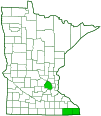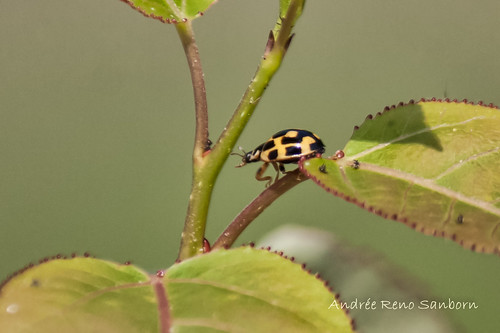fourteen-spotted lady beetle
(Propylea quatuordecimpunctata)
Conservation • Description • Habitat • Ecology • Distribution • Taxonomy
|
|
||||||||||||||
Description |
Fourteen-spotted lady beetle is an exotic, small, black-spotted lady beetle. It is native to Europe, where it is commonly used in greenhouses to control unwanted insects. The first North American reported sighting was near Ste-Foy, Quebec in 1968, but the species appears to have already been well established by that time. It was probably accidentally introduced by European ships in the St. Lawrence Seaway. In 1968, Propylea quatuordecimpunctata was intentionally released in the United States in the Great Plains states to control greenbugs, but it did not become established. Between 1970 and 1982 it was intentionally introduced into New Jersey, Delaware, Oklahoma, and Washington. None of these introductions became established. Between 1987 and 1992 it was reared and released in 16 western states to control the Russian wheat aphid. These did not become established. During all this time, the Quebec population continued to spread. The first recorded sighting of an established population of Propylea quatuordecimpunctata in the United States was in Grand Isle County, Vermont in 1984. In 1989 and 1990 it was propagated and released in Georgia, Iowa, Indiana, Maryland, Michigan, Minnesota, Missouri, New Jersey, and Pennsylvania. Fourteen-spotted lady beetle now occurs in the United States from Maine to Delaware, west to Minnesota and Iowa. It is common in the northeast, uncommon but increasing in Minnesota. Adults are active mostly from May to August. They are found in many different habitats, including forests, grasslands, meadows, fields, parks, lawns, and gardens. They feed on aphids, whiteflies, scale insects, and the larvae of beetles and butterflies. Adults are ⅛″ to 3⁄16″ (3.5 to 5.2 mm) long and ⅛″ (3.0 to 4.0 mm) wide. Males are smaller than females. The body is oval when viewed from above. When viewed from the side it is convex but slightly depressed in the middle. The upper surface is hairless and pale with black spots. The coloration and markings are highly variable, and this has resulted in several varieties being described. The ground color may be cream-colored, yellowish, yellow, or light orange (pale). The head is deeply inserted into the thorax. It is normally partially visible from above, but it can be retracted beneath the upper thoracic plate (pronotum). It is mostly yellow, but the top of the head (vertex) is black. The eyes are large and black. The antennae are yellow and longer than the head. They have 11 segments. The last three segments are slightly expanded into a weak club. The mouthparts are yellow. The jaws (mandibles) have two teeth at the tip. On the male, the upper part of the face (frons), corresponding to the forehead, is yellow. On the female, the plate on the face (clypeus) has a large black spot on the lower margin. The pronotum is wider than long and is widest at the rear. The rear angles are rounded and the front angles project forward. The rear margin is rounded. The upper surface is pale with two rectangular spots at the rear margin and four rectangular spots in the middle. The spots usually coalesce into a single large, black patch. The hardened wing covers (elytra) are pale and shiny, with fourteen rectangular spots, seven on each elytron. This is the feature that gives the beetle its common name and its species epithet. Each elytron also has a black stripe on the inner margin (sutural stripe). Four of the spots on the rear half usually merge into a broad U shape, and two spots in the front half merge into a rectangle. Together with the sutural stripe, this creates an anchor shape. Sometimes all of the spots are separate. Rarely they all coalesce, creating black elytra with pale spots. The legs are mostly yellow, but there is usually at least some black on the third segment (femur) of each leg. |
Size |
Total length: ⅛″ to 3⁄16″ (3.5 to 5.2 mm) |
Similar Species |
Habitat |
Forests, grasslands, meadows, fields, parks, lawns, and gardens |
Ecology |
Season |
April to September |
Behavior |
|
Life Cycle |
|
Larva Food |
|
Adult Food |
Aphids, whiteflies, scale insects, and the larvae of beetles and butterflies |
Distribution |
||
|
Sources |
|
| 7/7/2025 | ||
Occurrence |
||
Common in the northeast, uncommon but increasing in Minnesota |
||
Taxonomy |
|
Order |
Coleoptera (Beetles) |
Suborder |
Polyphaga (Water, Rove, Scarab, Long-horned, Leaf, and Snout Beetles) |
Infraorder |
Cucujiformia |
Superfamily |
Coccinelloidea (lady, fungus, scavenger, and bark beetles) |
Family |
|
Subfamily |
Coccinellinae (common lady beetles) |
Tribe |
Coccinellini (black-spotted lady beetles) |
Genus |
Propylea |
Genus |
|
Subordinate Taxa |
|
Several varieties have been described, but these are usually treated as forms. |
|
Synonyms |
|
Coccinella 14-punctata Coccinella quatuordecimpunctata Halyzia (Propylaea) 14-punctata Propylea 14-punctata Propylaea quatuordecimpunctata Propyleae quatuordecimpunctata |
|
Common Names |
|
14-spotted lady beetle 14-spotted ladybird (UK) 14-spot ladybird (UK) checkerspot ladybeetle fourteen-spotted lady beetle fourteen-spotted ladybug fourteen-spotted ladybird (UK) fourteen-spot ladybird (UK) |
|
Glossary
Clypeus
On insects, a hardened plate on the face above the upper lip (labrum).
Elytra
The hardened or leathery forewings of beetles used to protect the fragile hindwings, which are used for flying. Singular: elytron.
Femur
On insects and arachnids, the third, largest, most robust segment of the leg, coming immediately before the tibia. On humans, the thigh bone.
Frons
The upper front part of an insect’s face, roughly corresponding to the forehead.
Pronotum
The exoskeletal plate on the upper side of the first segment of the thorax of an insect.
Vertex
The upper surface of an insect’s head.
Visitor Photos |
||
Share your photo of this insect. |
||
This button not working for you? |
||
Mike Poeppe |
||
 |
||
Alfredo Colon |
||
 |
||
 |
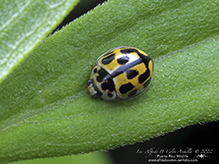 |
|
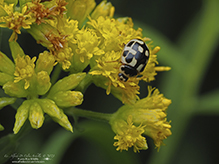 |
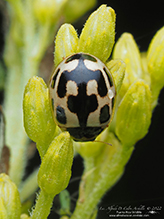 |
|
MinnesotaSeasons.com Photos |
||
|
||
|
||

Visitor Videos |
||
Share your video of this insect. |
||
This button not working for you? |
||
|
Other Videos |
||
14-spotted ladybird (Propylea quatuordecimpunctata) |
About
Sep 15, 2019 14-spotted ladybird (Propylea quatuordecimpunctata) The 14-spotted ladybird is a small lady beetle, belonging to the family Coccinellidae. It is sometimes referred to by the common name 14-spotted ladybird beetle, or simply P-14. Wikipedia Scientific name: Propylea quatuordecimpunctata |
Schaakbordlieveheersbeestje Propylea quatuordecimpunctata, paring |
About
May 20, 2019 11-V-2019, Leiden. Schaakbordlieveheersbeestje Propylea quatuordecimpunctata, paring / copula Insecta (Insecten, insects, Insekten, insectes), Coleoptera (kevers, beetles, Käfer, coléoptères), Coccinellidae (lieveheersbeestjes, ladybugs, ladybirds, ladybird beetles, lady beetles, Marienkäfer, coccinellidés, coccinelles) |
Propylea Quatuordecimpunctata | Fourteen-spotted ladybug Coleoptera Animal life |
About
Sep 23, 2022 |

Visitor Sightings |
||
Report a sighting of this insect. |
||
This button not working for you? |
||
Mike Poeppe |
Location: near Houston, MN |
 |
| Alfredo Colon 7/7/2024 |
Location: Albany, NY |
 |
| Alfredo Colon 6/17/2024 |
Location: Albany, NY |
 |
| Alfredo Colon 8/26/2022 |
Location: Albany, NY |
 |
| Alfredo Colon 8/17/2022 |
Location: Albany, NY |
 |
| Alfredo Colon 8/4/2022 |
Location: Albany, NY |
 |
MinnesotaSeasons.com Sightings |
||
|

Created: 1/3/2024 Last Updated: © MinnesotaSeasons.com. All rights reserved. |
